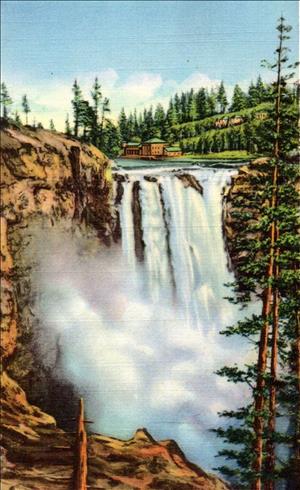Snoqualmie Falls is a 276-foot waterfall on the Snoqualmie River about 30 miles east of Seattle on the way to Snoqualmie Pass. The falls have been for generations a sacred site for the Snoqualmie Tribe and a source of hydraulic power. By 1998, it was the second-most visited tourist attraction in Washington after Mount Rainier.
Sacred Site
The Snoqualmie Tribe believes that Snoqualm, or Moon the Transformer, created the world. Snoqualm later created Snoqualmie Falls out of a fish trap. He transformed the trap into a waterfall with the hopes of allowing the salmon to swim upstream. He was unsuccessful, and to this day, the 276-foot waterfall keeps salmon from spawning in the upper valley. The tribe regards the falls as a sacred site.
The first non-Native to see the falls was Washington Hall, a surveyor who in 1848 was guided by Indians to the site. In 1851, explorer Samuel Hancock visited the falls and wrote the first published account of the event. In 1855, Edward Warbass (1825-1906) led the first tourist expedition, a party of 15 men and women, to the falls. By this time a handful of settlers inhabited the upper valley, and they were able to follow trails from Seattle, about 30 miles to the west. Their tale was printed in the Seattle Weekly Gazette, which most likely heightened local interest in the spectacle.
The Seattle, Lake Shore & Eastern railway completed a rail line as far as North Bend in 1889. The first train to visit the falls was, unsurprisingly, a tourist excursion. With the rail line in place, Snoqualmie Falls's role as a mecca for travelers was set. Later that year, naturalist John Muir visited the falls and described them as the most interesting falls he had seen. In 1893, a young daredevil leaped off of the falls with a parachute, in a well-attended, advertised show. To the horror of onlookers, he got caught in the updraft and smashed into the rockface. Rescuers carried him up from the base of the waterfall in the hopes of transporting him by train to a Seattle hospital, but they were too late.
Power Source
Charles H. Baker was an engineer for the rail line in its early days, and saw an amazing potential for the surging flow of water during his many sojourns above it. After becoming unemployed in the economic Panic of 1893, he convinced his wealthy father to finance his idea of building a power generator deep within the rock beneath the falls. Work began in 1898, and for the next year the river was diverted from the southern side of the waterfall. A shaft was drilled into the rock, and through it equipment brought down. Later, an eight-foot diameter pipe to channel water through was placed in the shaft. The force of the fall drove four waterwheels in a subterranean chamber, and this resulting energy was brought up through cables to a transformer house which and converted it into 32,000 volts of electricity. On July 31, 1899, at a public ceremony, Baker's 18-month-old daughter Dorothy pulled the switch to start the whole process. More than 100 years later, this equipment was still in operation.
Early photos of the falls show a large rock in the center of the brink. This rock, known as Seattle Rock, was dynamited in 1900, after causing too many logjams near the top. At the same time, a small dam was built to maintain water levels for the power plant during the dry summer months. Over the years, the falls continued to beckon tourists and travelers. In the early part of the twentieth century, the Sunset Highway was built from Kirkland, making the area easily accessible by automobile. In 1919, the Snoqualmie Falls Lodge was opened on the north side of the falls to cater to weekend motorists. Today, at the same location, the Salish Lodge carries on this tradition in a more elegant fashion.
An observation deck, built in 1968, provides the vantage point for the millions of photographs that are taken of the falls. Snoqualmie Falls receives more than 1.5 million visitors each year. The falls provide the energy to generate electricity, and they remain sacred to the Indians.

